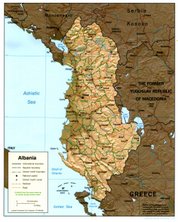This is the title of an interesting conference that took place at the University of Buffalo (N.Y.) on April 18-19, 2009.
The following excerpts are taken from the site of the Institute of European and Mediterranean Archaeology of The State University of New York, which documents this conference that includes studies made in Albania by Michael Galaty, Ph. D., Associated Professor of Anthropology at Millsaps College, in Jackson. MS.
"The Archaeology of Violence:
An integrated approach to the study of violence and conflict"
Today, violence is an everyday occurrence and we are always reminded that violent encounters are never that far away. As a result, people have come to expect violence as part of everyday life. Whether experienced at the group or individual level, the ‘emotional, economic, demographic, logistic and political impact of violence reaches well beyond its physical location’ (Shiels et al. 2008).
This conference aims to consider the causes, actions and effects of violence through the study of skeletal remains, identity, literature, iconography, ritual behavior, and landscapes. Violence plays an important role in the development of social-political systems in the past and therefore, its archaeological identification is an essential part of our understanding of social change, both on a micro- as well as the macro-scale. Studying the material remains of violence allows us ‘to consider the importance of violent interaction and its impact upon family and settlement units; and to explore the function, causes and consequences of violent interaction in different groups and societies’ (Shiels et al. 2008).
The interdisciplinary nature of this conference will allow for a variety of research to be presented and will highlight the diversity of approaches to violence and the consequences for understanding social, political and economic relationships between individuals, kin, communities and society as a whole.
> Shiels, D., L. Fibiger, W.O. Frazer and C. Murphy. 2008. Abstract for Session at WAC-6 “Changing identities: exploring the materiality of conflict I”.
======
Michael L. Galaty, Department of Anthropology, Millsaps College, MS
“An offense to honor is never forgiven…”: Violence and Landscape Archaeology in Highland Northern Albania
Northern Albania is the only place in southern Europe where tribal societies survived intact into the 20th century, including tribal councils and chiefs, an oral customary law code (the Kanuni i Lekë Dukagjini), and blood feuds and warfare. Since 2004 the Shala Valley Project (SVP) has studied one of these tribes, the Shala, whose tribal territory encompasses the upper reaches of the Shala River. The SVP supports interdisciplinary programs of archaeological, ethnographic, and ethno- and archival historical research. In three seasons of fieldwork (2005-2007), 999 fields were subjected to intensive archaeological survey, 580 structures were mapped and fully documented, and 36 heads of household participated in detailed formal interviews. Three historians accessed documents pertaining to northern Albania housed in Albania, Austria, Italy, Turkey, the United Kingdom, and the United States. Taken together, these data paint an interesting picture of the origins and evolution of the Shala tribe, beginning in the 15th century AD through the present day. Fully interpreting this picture, however, is almost impossible without considering the effects of violence. In this paper I consider the various ways Shala’s tribal system and shifting settlement patterns are reflected in the regional landscape, and how these responded to endemic violence, including feud and warfare. It seems likely that violence worked to relieve demographic and economic pressure, which was critically important given Shala’s harsh environment, but that contests between individuals and clans, for access to social and political power, underpinned most incidents of feud and decisions to go to war. Our work in Shala helps demonstrate the various impacts violence may have had on settlement and landscape the world over, in periods of prehistory and history, and demonstrates the power of integrated approaches to violence and conflict to inform archaeological data.
Friday, May 15, 2009
Subscribe to:
Post Comments (Atom)





No comments:
Post a Comment